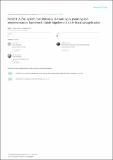| dc.contributor.author | Ketele, Paul | |
| dc.contributor.author | Derese, Anselme | |
| dc.contributor.author | Boruett, Norbert | |
| dc.contributor.author | Jacobs, Anouk | |
| dc.date.accessioned | 2022-04-04T13:36:03Z | |
| dc.date.available | 2022-04-04T13:36:03Z | |
| dc.date.issued | 2010-09 | |
| dc.identifier.citation | Ketele P, Jacobs A, Boruett N, Derese A. PerSIST: a PAL system for clinical skills training: a planning and implementation framework: Guide Supplement 30.8--practical application. Med Teach. 2010;32(9):782-4. doi: 10.3109/0142159X.2010.507717. PMID: 20795812. | en_US |
| dc.identifier.issn | 0142–159X print | |
| dc.identifier.issn | 1466–187X online | |
| dc.identifier.other | DOI:10.3109/0142159X.2010.507717 | |
| dc.identifier.other | PMID: 20795812 | |
| dc.identifier.uri | https://repository.amref.ac.ke/handle/123456789/644 | |
| dc.description | This AMEE Guide was published as: Ross and Cameron
(2007). Peer assisted learning: a planning and implementation
framework: AMEE Guide no. 30. Med Teach 29: 527–545. | en_US |
| dc.description.abstract | Context
Involving peers as skills tutors has become an increasingly
interesting tool in medical and nursing schools worldwide. The
Association for Medical Education in Europe (AMEE) adopted
the term peer-assisted learning (PAL) to refer to this particular
method of learning (Ross & Cameron 2007). PAL is associated
with cognitive, pedagogical, attitudinal, social, and economic
benefits (Ross & Cameron 2007). In general, the subjective
feedback from students on PAL initiatives appears to be very
positive (Topping 1996). Peer tutoring has a positive impact on
the academic achievements of healthcare students (Santee &
Garavalia 2006).
A variety of PAL types is currently available and operational.
In one method, senior students teach junior students in
theoretical and/or practical subjects. This way of ‘‘cross-year
teaching’’ is predominantly evaluated as ‘‘effective’’ and
‘‘positive’’ by students in healthcare education (Sobral 2002;
Nestel & Kidd 2003; Kernan et al. 2005; Goldsmith et al. 2006).
However, PAL also appears to be very useful when student
tutees and student tutors are from the same year.
Opportunities where same year students support each other
during clinical skills training sessions suggest that PAL could
add value to their clinical skills acquisition (Iwasiw &
Goldenberg 1993; Field et al. 2007). | en_US |
| dc.language.iso | en | en_US |
| dc.publisher | Medical Teacher | en_US |
| dc.subject | Association for Medical Education in Europe (AMEE) | en_US |
| dc.subject | Peer-assisted learning (PAL) | en_US |
| dc.subject | Students | en_US |
| dc.subject | Healthcare education | en_US |
| dc.subject | Skillslab | en_US |
| dc.subject | Classmates | en_US |
| dc.subject | Training | en_US |
| dc.subject | Facilitate | en_US |
| dc.title | PerSIST: A PAL System for Clinical Skills Training: A Planning and Implementation Framework: Guide Supplement 30.8-Practical Application | en_US |
| dc.type | Article, Journal | en_US |

